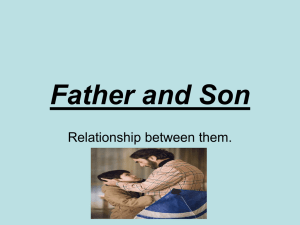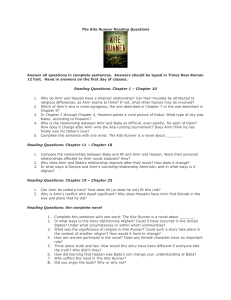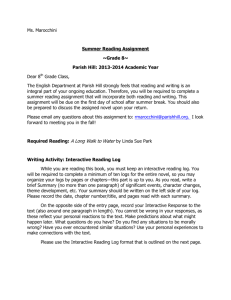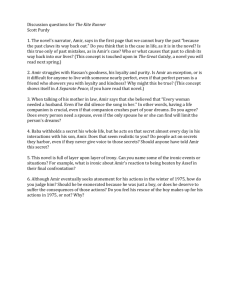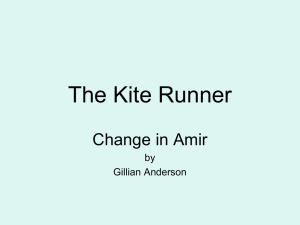The Kite Runner Concept Analysis
advertisement
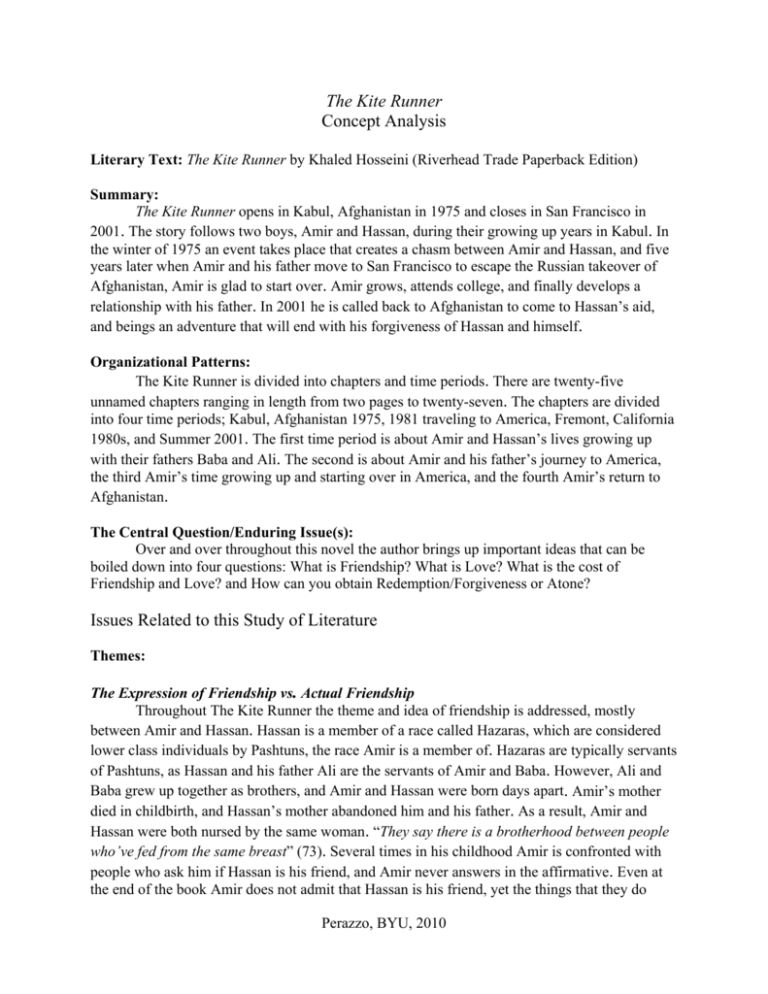
The Kite Runner Concept Analysis Literary Text: The Kite Runner by Khaled Hosseini (Riverhead Trade Paperback Edition) Summary: The Kite Runner opens in Kabul, Afghanistan in 1975 and closes in San Francisco in 2001. The story follows two boys, Amir and Hassan, during their growing up years in Kabul. In the winter of 1975 an event takes place that creates a chasm between Amir and Hassan, and five years later when Amir and his father move to San Francisco to escape the Russian takeover of Afghanistan, Amir is glad to start over. Amir grows, attends college, and finally develops a relationship with his father. In 2001 he is called back to Afghanistan to come to Hassan’s aid, and beings an adventure that will end with his forgiveness of Hassan and himself. Organizational Patterns: The Kite Runner is divided into chapters and time periods. There are twenty-five unnamed chapters ranging in length from two pages to twenty-seven. The chapters are divided into four time periods; Kabul, Afghanistan 1975, 1981 traveling to America, Fremont, California 1980s, and Summer 2001. The first time period is about Amir and Hassan’s lives growing up with their fathers Baba and Ali. The second is about Amir and his father’s journey to America, the third Amir’s time growing up and starting over in America, and the fourth Amir’s return to Afghanistan. The Central Question/Enduring Issue(s): Over and over throughout this novel the author brings up important ideas that can be boiled down into four questions: What is Friendship? What is Love? What is the cost of Friendship and Love? and How can you obtain Redemption/Forgiveness or Atone? Issues Related to this Study of Literature Themes: The Expression of Friendship vs. Actual Friendship Throughout The Kite Runner the theme and idea of friendship is addressed, mostly between Amir and Hassan. Hassan is a member of a race called Hazaras, which are considered lower class individuals by Pashtuns, the race Amir is a member of. Hazaras are typically servants of Pashtuns, as Hassan and his father Ali are the servants of Amir and Baba. However, Ali and Baba grew up together as brothers, and Amir and Hassan were born days apart. Amir’s mother died in childbirth, and Hassan’s mother abandoned him and his father. As a result, Amir and Hassan were both nursed by the same woman. “They say there is a brotherhood between people who’ve fed from the same breast” (73). Several times in his childhood Amir is confronted with people who ask him if Hassan is his friend, and Amir never answers in the affirmative. Even at the end of the book Amir does not admit that Hassan is his friend, yet the things that they do Perazzo, BYU, 2010 together, and the way they associate together gives the impression that they are friends. This begs the question of what is friendship and how do you know if you have created it? Redemption/Atonement is Possible Almost from the first page we learn that this is the major theme in the novel. When Rahim Kahn, a friend of Baba’s, calls Amir in California he ends their brief conversation with the words, “There is a way to be good again” (2). When Amir was a child, he and Hassan would attend the yearly kite flying tournaments. The kites were made for the purpose of fighting other kites in the air (glass was glued to the strings to cut competitor kites), and when a kite fell there was a mad dash (“running”) to see who would catch the cut kite. There were two ways to win – by being the last kite in the air and by “running” the second to last kite. During the tournament in 1975, Amir desperately wants to win the competition to secure his father’s love for him, and the victory would only be complete by being the last kite in the air and running the last kite to be cut. Hassan runs the kite for Amir out of devotion, but is ambushed by the neighborhood bully – a sociopath named Assef – and when Amir finds them Assef is raping Hassan. Amir does nothing to defend his “friend” and this becomes the central event in the book that haunts Amir for the rest of his life. Subsequent sins wedge themselves between Amir and Hassan, and when Rahim Kahn calls to have Amir atone for these sins, Amir is less than excited but knows that he must. The entire book revolves around the way this event taints Amir’s life and his process to achieve atonement from these sins. Stealing is the Only Sin When Amir is young he learns in school about the Islamic faith and what Muslims believe is right and wrong. There is a whole list of both, which he asks his father about. Baba ridicules the highly religious and teaches Amir that there is only one kind of sin – stealing. If you kill someone, you steal a man’s right to life and his family’s right to a father and husband. If you steal food, you steal someone’s right to make a profit and run a business. Lying is robbing someone of their right to the truth. In Baba’s mind, all major crimes are a result of theft, and if theft is not involved then there has been no sin. This definition comforts and haunts Amir throughout his life. As a child, it was his birth that killed his mother, so Amir worries that he must somehow obtain forgiveness from his father for his sin. As an adult, he allows Assef to steal Hassan’s innocence, the guilt he carries through his life. Each of the characters have “stolen” something, and each seek to find an ease from the guilt that causes. Real Love vs. Imagined Love The reason that Amir is so desperate to win the kite tournament is because he feels it is his only way to receive his father’s love. He seeks throughout his childhood to do things that will make his father love him. Hassan does things for Amir because he loves him, and believes that his love is requited by Amir. Amir even says to him, “You’re a prince, Hassan. You’re a prince and I love you” (30). However, in these characters actions we question what love is. For Hassan, his love was always pure and true. But it isn’t until Amir and his father go to America that Baba shows real love for Amir, and Amir for Baba. And it isn’t until Amir returns to Afghanistan that Perazzo, BYU, 2010 he shows real love for Hassan. Amir meets and falls in love with his wife Soraya, and she seems to be easy for Amir to fall for. He knows her past from the beginning of their relationship and has no problems showing her love. Other Themes: The Role of Religion/God, The internal conflict inside everyone for good and evil, Racism, the Role of Government on Life. Setting: The Kite Runner takes place in a few different locations, first in the Wazir Akbar Khan district in northern Kabul, Afghanistan. The climate there goes from summer where it is hot and dry to winter when it snows. It starts in 1975 when the Afghani monarchy falls to a coup and a new president takes over. The setting stays in Kabul until 1981 when the Russians take control of Afghanistan, and Amir and Baba leave for America. The setting shifts to Fremont, California during the 1980s and 1990s until the summer of 2001, when Amir returns to Kabul, Afghanistan through Peshawar, Pakistan. As much of the novel takes place in the Middle East, there are many customs, places, and events that take place that are unfamiliar to Westerners. To understand the novel, some study should take place on the culture of Afghanis, as well as the geography of Kabul: both political and geographical. Most of the terms that are unfamiliar are in italics as they are in Farsi, so they are easy for a teacher or students to pick out and define. Point of View/Narrative Voice: This novel is told in first person. It is told as a frame story – the narrator (Amir) is looking back on his life, but it is only for the first three chapters that are told in first person past tense – looking back. Then Amir takes up the story as first person present tense. Literary Terms Important to the Novel: Because of the deep themes in this novel I would read it with high school seniors or juniors. The prose isn’t difficult, but there are occasional swear words, four f-bombs, and the one graphic scene mentioned earlier. Because of the age that would be reading this, the following terms would be appropriate to discuss in connection with the novel: • • • • Foreshadowing. This occurs frequently in the novel because it is a frame story told by a narrator who is looking back. Characterization. Creating character graphics for each character to understand them better visually. Hero. This would in interesting because this plot has two heroes that could be discussed and debated. Symbol. There are three specific symbols that would be important to discuss. First the symbolism of blood throughout the story – blood in connection to Hassan’s heritage, blood with Hassan’s rape, blood with Baba’s illness, blood Perazzo, BYU, 2010 • • • • with Amir’s fight for atonement, and blood and Sohrab, Hassan’s son. Second the orphanages mentioned during the story – the one that Baba built, Sohrab’s orphanage experience, ect. Third, glasses and their significance – Baba, Rahim Karim, the old man who knows Amir’s mother, the “man in sunglasses,” the operator of the orphanage, and Amir and Hassan. How does glasses affect their vision and characterization? Irony. This is another major theme to be discussed from the beginning with Amir’s first story to the end with Sohrab and Amir. There are countless examples of this (the orphanage is another example). Metaphor Flashback Imagery Affective Issues Related to the Work: This novel deals with several of the big issues in life; the one which is probably the most related is the theme of friendship. In High School, students see friendships and their dissolution everywhere. They have had friends that they loved, and friends that they didn’t really consider friends. They know what friendship feels like, but to have to define it and see it used in different ways could be something that is new or eye opening for them. Also the theme of Amir and Hassan’s friendship can relate to students when you consider the racial theme of their friendship. Amir and Hassan are “friends” from opposite races. Their ancestors have killed each other. Their current society enslaves Hassan’s people and looks down on them. These racial themes have connection to the world that students live in – friends who are black and white, Hispanic and white, or black and Hispanic. Students see the division of society along racial lines, and can appreciate the friendship of Amir and Hassan for those reasons. Another theme that relates to students is the conflict that Amir faces. His conflict is almost entirely internal. He does not stand up for a friend and is forced to deal with his actions for the rest of his life. He somewhat struggles to form trusting relationships, forgives everyone because of the graveness of his own sin, blames his and Soraya’s lack of children on himself as a continued punishment for his crime, and carries the burden of guilt until he is almost forty. It isn’t until he goes to Afghanistan and saves Sohrab that he is able to find himself free of his guilt, confess his sin out loud, and move on. Students can understand this feeling of guilt and of being so ashamed that they carry their guilt in their pocket. This novel shows these students that there is a way out of this weight, and that other people suffer to do the right thing too. I think that students can also see that there is a way to atone for those things and find peace in the world; “There is a way to be good again.” Students will also find the idea of matrimony and dating in the novel interesting. Soraya and Amir are very strictly allowed to see each other and they are never allowed to be alone, up until the wedding night. The wedding is arranged by the fathers – neither of them can say much Perazzo, BYU, 2010 to go against the traditional colors or food. This is an interesting issue for students that they will want to discuss in detail, especially if they are juniors or seniors in high school who are just starting to create serious dating relationships. A last affective issue is the setting of the novel. For many students, all they know about Afghanistan is that there were bad people named the Taliban living there, there is a war with soldiers fighting there, and it is hot. Most of them probably do not even know that it snows there, or that the students don’t have school during winter. The setting and culture that this book exposes is interesting to students who want to know more about other people and cultures in the world. Vocabulary Issues/Background Knowledge: I have tied these two ideas together because the main vocabulary issues in this novel come from the background knowledge that students need before they can fully comprehend the words. Students reading this book should first have studied the Middle East and the cultures and history there. The author will occasionally define terms or history, but in many cases he relies upon the reader to understand. Teachers uninterested in pre-teaching vocabulary will hope that their students will be able to tell from the textual clues what each foreign word means and in some cases they will be able to. But teachers who want their students looking for textual significance will work with students on the words and locations beforehand. Below is a notcomprehensive list of terms that the book notes that are not defined by the author: • Wazir Akbar Khan • Kabul • Calcutta • Baba • Alla-u-akbar • Mashad • Shi’a Muslim • Sunni Muslims • Bazaar • Naan • Mullah • Zakat • Hadj • Namaz • Kofta • Jan • Khayyam • Hafez • Rumi • Masnawi Perazzo, BYU, 2010 • • • • • • • • Buzkashi Chapandaz Tehran Hashish Mast Agha sahib Mashallah Inshallah Beyond these words, the vocabulary is basic. All of the English words should be very accessible to students and well understood. Implications for Students with Diversity: Because this book addresses a culture that is not widely understood in the West, there will be a fairly equal level of understanding for this book. This book also addresses several concerns that are well known by students of diversity in the United States – issues like culture shock, trying to keep your culture separate from the norm while still blending in in society, racism, money problems, working odd jobs for money, graduating from high school older than everyone else, learning another language, and fitting in. These ideas should be taught and discussed in very respectful ways. Teachers who know that they have students who have recently come to the United States may want to ask them to share their feelings on immigrating. Teachers may also ask students to interview someone who has immigrated to the United States. Students with special needs should receive the proper scaffolding to aid their understanding of the text. Since the novel is fairly long, giving chapter summaries or cutting out chapters that are not as important may be a useful strategy for helping these students stay on track with their peers. Gender Issues: The biggest gender issues in this book relate to the culture of Middle Eastern Society. Amir must address all adults as “Kaka” or “Khala” – uncle and aunt – regardless of his blood relation to them. However this is a minor gender issue compared to the process of courting a woman to marry her. When Amir is attracted to Soraya he knows that he can never sit alone with her because of the gossip people would say about her. He gets to know her through his conversations with Soraya and her mother, who wants Amir to marry her daughter. Amir states, “I cringed a little at the position of power I’d been granted, and all because I had won the genetic lottery that had determined my sex” (149). When Amir decides that he wants to marry Soraya, he has to have his father Baba meet with her father, General Taheri, to ask for Soraya’s hand. The general consents, and there is a long courtship process that begins. Because Baba is in failing health, the full length (three Perazzo, BYU, 2010 months) of the courtship is cut short, and so after a betrothal dinner (which Soraya is not allowed to come to due to custom), the wedding is held. At the wedding, Soraya is the only woman allowed to sit at the head table. However, even after the wedding Soraya and Amir’s relationship is not considered perfect. When Soraya was eighteen she ran away from her parents with an Afghani man. They lived “in sin” for a few days until her father showed up to take her back. Since then, no suitors had come calling for her, despite her beauty. Men and women alike considered her dirty and foul and she was the source of much gossip, and continue to gossip about her after her marriage to Amir. It is a source of much grief for Soraya, who says, “Their sons go out to nightclubs…and get their girlfriends pregnant, they have kids out of wedlock, and no one says a thing…I make one mistake and suddenly everyone is talking nang and namoos, and I have to have my face rubbed in it for the rest of my life” (179). Clearly gender roles are a topic of discussion for this book, and it is interesting that although there is much that governs Soraya in terms of men and relationships, she is free to choose the career of her choice and go to school. Amir’s mother’s career as a professor at a university is mentioned, as is the high status it was for her to work there and do so well teaching. It seems that women in this culture are free (within the bounds of their ability) to become members of whatever profession they choose. It is also interesting that when Soraya is deemed infertile the narrator mentions no one thinking twice about it. However, it is important to remember the topic of gender roles in the context of Afghani culture. It isn’t fair to judge our culture to be better because we allow free choice in marriage. Or do we? There are lots of things to say in relation to gender roles and suppositions in our Western culture as well. Research Issues/Project Ideas: The following are a list of project ideas for further research and introspection with the text: • Relationship Brochure: Let students pick two of the main characters and have them create a brochure or some other kind of visual representation of the character’s relationship. They should use summaries, quotes, and ideas from the book as much as possible to convey the full relationship and its meaning for both characters. • Next Chapter: Have students write the next chapter of the book. Or the concluding Epilogue to the book, so they can complete the story how they think it should be done. Enrichment Resources: The following are a list of enrichment resources that could be used to further students knowledge about the text or the themes it portrays: • A movie from the Middle East that displays every-day life in that region. Try to get one as close to Kabul as possible. Perazzo, BYU, 2010 • • Watch the movie The Kite Runner and have students analyze how the movie portrays the book and decide which they like better. Find articles and resources that describe Afghanistan today or articles from Afghanistan during the occupation of the Russians or Taliban. Have students put the books events into perspective of what was actually taking place. Perazzo, BYU, 2010
